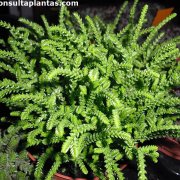Care of the succulent plant Crassula muscosa or Watch chain |
|
The genus Crassula, family Crassulaceae, includes 600 species of succulent plants native to southern Africa. Some species are: Crassula muscosa, Crassula multicava, Crassula marnierana, Crassula falcata, Crassula capitella, Crassula Buddha's Temple (cultivar), Crassula arborescens, Crassula ovata, Crassula tetragona, Crassula arta, Crassula radicans, Crassula Coralita, Crassula picturata, Crassula corymbulosa, Crassula perforata. Common names: Zipper plant, Princess pines, Lizard's tail, Watch chain, Rattail crassula. Scientific synonym: Crassula lycopodioides. This species is native to Namibia and South Africa. They are small succulent subshrubs that reach 30 cm (11.8") in height. The fine branching stems are covered with tiny leaves embedded in 4 vertical rows. They produce tiny creamy or greenish flowers that emit perfume, especially indoors. They bloom during spring and summer. Watch chain is used in pots as indoor plants or greenhouses; if the weather permits, it's used in rockeries. Crassula muscosa can grow in full sun exposures but prefers a light shade exposure outdoors or a brightly lit exposure indoors. It does not resist temperatures below 5ºC. The soil can be a mixture of peat or leaf mulch with 40% siliceous sand. In summer, water waiting for the substrate to dry. In winter Zipper plant needs rest; water only once a month. Fertilize with compost every 2 years in spring. Princess pines does not need pruning. Crassula muscosa does not usually has pest and disease problems; avoid overwatering. Crassula lycopodioides propagates by stem cuttings quite easily. |
Images of the succulent plant Crassula muscosa or Watch chain |
Find plants
Crassula muscosa or Watch chain | Care and Growing
© 2026 FavThemes


